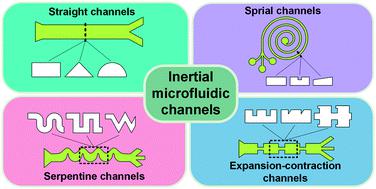Our official English website, www.x-mol.net, welcomes your
feedback! (Note: you will need to create a separate account there.)
Channel innovations for inertial microfluidics.
Lab on a Chip ( IF 6.1 ) Pub Date : 2020-09-07 , DOI: 10.1039/d0lc00714e Wenlai Tang 1 , Shu Zhu , Di Jiang , Liya Zhu , Jiquan Yang , Nan Xiang
Lab on a Chip ( IF 6.1 ) Pub Date : 2020-09-07 , DOI: 10.1039/d0lc00714e Wenlai Tang 1 , Shu Zhu , Di Jiang , Liya Zhu , Jiquan Yang , Nan Xiang
Affiliation

|
Inertial microfluidics has gained significant attention since first being proposed in 2007 owing to the advantages of simplicity, high throughput, precise manipulation, and freedom from an external field. Superior performance in particle focusing, filtering, concentrating, and separating has been demonstrated. As a passive technology, inertial microfluidics technology relies on the unconventional use of fluid inertia in an intermediate Reynolds number range to induce inertial migration and secondary flow, which depend directly on the channel structure, leading to particle migration to the lateral equilibrium position or trapping in a specific cavity. With the advances in micromachining technology, many channel structures have been designed and fabricated in the past decade to explore the fundamentals and applications of inertial microfluidics. However, the channel innovations for inertial microfluidics have not been discussed comprehensively. In this review, the inertial particle manipulations and underlying physics in conventional channels, including straight, spiral, sinusoidal, and expansion–contraction channels, are briefly described. Then, recent innovations in channel structure for inertial microfluidics, especially channel pattern modification and unconventional cross-sectional shape, are reviewed. Finally, the prospects for future channel innovations in inertial microfluidic chips are also discussed. The purpose of this review is to provide guidance for the continued study of innovative channel designs to improve further the accuracy and throughput of inertial microfluidics.
中文翻译:

惯性微流体的通道创新。
自2007年首次提出以来,由于其简单,高通量,精确的操作以及不受外界干扰的优点,惯性微流体技术受到了广泛的关注。已经证明了在粒子聚焦,过滤,浓缩和分离方面的卓越性能。作为一种被动技术,惯性微流技术依靠在惯性的雷诺数范围内非常规地利用流体惯性来诱导惯性迁移和二次流,而惯性迁移和二次流直接取决于通道结构,从而导致粒子迁移到侧向平衡位置或被捕集。一个特定的空腔。随着微加工技术的进步,在过去的十年中已经设计和制造了许多通道结构,以探索惯性微流体的基础和应用。但是,尚未对惯性微流体的通道创新进行全面讨论。在这篇综述中,简要介绍了常规通道(包括直线,螺旋,正弦和膨胀-收缩通道)中的惯性粒子操纵和基础物理学。然后,回顾了惯性微流体通道结构的最新创新,特别是通道模式的修改和非常规的横截面形状。最后,还讨论了惯性微流控芯片中未来通道创新的前景。本文的目的是为继续研究创新的通道设计提供指导,以进一步提高惯性微流体的准确性和通量。在这篇综述中,简要介绍了常规通道(包括直线,螺旋,正弦和膨胀-收缩通道)中的惯性粒子操纵和基础物理学。然后,回顾了惯性微流体通道结构的最新创新,特别是通道模式的修改和非常规的横截面形状。最后,还讨论了惯性微流控芯片中未来通道创新的前景。本文的目的是为继续研究创新的通道设计提供指导,以进一步提高惯性微流体的准确性和通量。在这篇综述中,简要介绍了常规通道(包括直线,螺旋,正弦和膨胀-收缩通道)中的惯性粒子操纵和基础物理学。然后,回顾了惯性微流体通道结构的最新创新,特别是通道模式的修改和非常规的横截面形状。最后,还讨论了惯性微流控芯片中未来通道创新的前景。本文的目的是为继续研究创新的通道设计提供指导,以进一步提高惯性微流体的准确性和通量。综述了惯性微流体通道结构的最新创新,尤其是通道模式的修改和非常规的横截面形状。最后,还讨论了惯性微流控芯片中未来通道创新的前景。本文的目的是为继续研究创新的通道设计提供指导,以进一步提高惯性微流体的准确性和通量。综述了惯性微流体通道结构的最新创新,尤其是通道模式的修改和非常规的横截面形状。最后,还讨论了惯性微流控芯片中未来通道创新的前景。本文的目的是为继续研究创新的通道设计提供指导,以进一步提高惯性微流体的准确性和通量。
更新日期:2020-09-29
中文翻译:

惯性微流体的通道创新。
自2007年首次提出以来,由于其简单,高通量,精确的操作以及不受外界干扰的优点,惯性微流体技术受到了广泛的关注。已经证明了在粒子聚焦,过滤,浓缩和分离方面的卓越性能。作为一种被动技术,惯性微流技术依靠在惯性的雷诺数范围内非常规地利用流体惯性来诱导惯性迁移和二次流,而惯性迁移和二次流直接取决于通道结构,从而导致粒子迁移到侧向平衡位置或被捕集。一个特定的空腔。随着微加工技术的进步,在过去的十年中已经设计和制造了许多通道结构,以探索惯性微流体的基础和应用。但是,尚未对惯性微流体的通道创新进行全面讨论。在这篇综述中,简要介绍了常规通道(包括直线,螺旋,正弦和膨胀-收缩通道)中的惯性粒子操纵和基础物理学。然后,回顾了惯性微流体通道结构的最新创新,特别是通道模式的修改和非常规的横截面形状。最后,还讨论了惯性微流控芯片中未来通道创新的前景。本文的目的是为继续研究创新的通道设计提供指导,以进一步提高惯性微流体的准确性和通量。在这篇综述中,简要介绍了常规通道(包括直线,螺旋,正弦和膨胀-收缩通道)中的惯性粒子操纵和基础物理学。然后,回顾了惯性微流体通道结构的最新创新,特别是通道模式的修改和非常规的横截面形状。最后,还讨论了惯性微流控芯片中未来通道创新的前景。本文的目的是为继续研究创新的通道设计提供指导,以进一步提高惯性微流体的准确性和通量。在这篇综述中,简要介绍了常规通道(包括直线,螺旋,正弦和膨胀-收缩通道)中的惯性粒子操纵和基础物理学。然后,回顾了惯性微流体通道结构的最新创新,特别是通道模式的修改和非常规的横截面形状。最后,还讨论了惯性微流控芯片中未来通道创新的前景。本文的目的是为继续研究创新的通道设计提供指导,以进一步提高惯性微流体的准确性和通量。综述了惯性微流体通道结构的最新创新,尤其是通道模式的修改和非常规的横截面形状。最后,还讨论了惯性微流控芯片中未来通道创新的前景。本文的目的是为继续研究创新的通道设计提供指导,以进一步提高惯性微流体的准确性和通量。综述了惯性微流体通道结构的最新创新,尤其是通道模式的修改和非常规的横截面形状。最后,还讨论了惯性微流控芯片中未来通道创新的前景。本文的目的是为继续研究创新的通道设计提供指导,以进一步提高惯性微流体的准确性和通量。











































 京公网安备 11010802027423号
京公网安备 11010802027423号